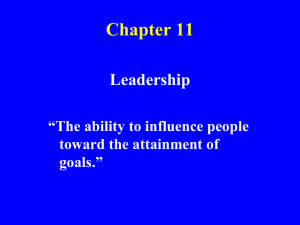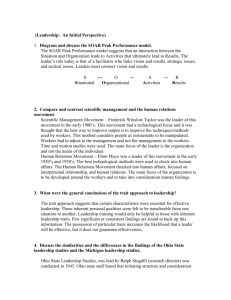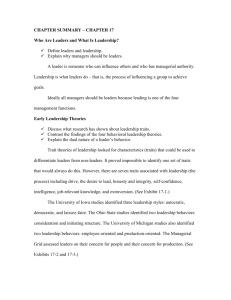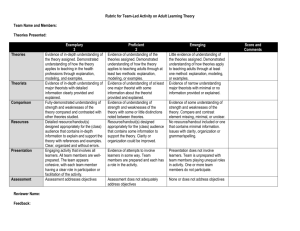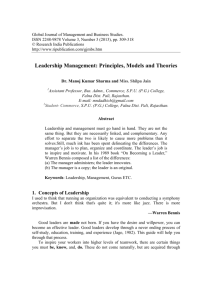Leadership Theories - Henman Performance Group
advertisement
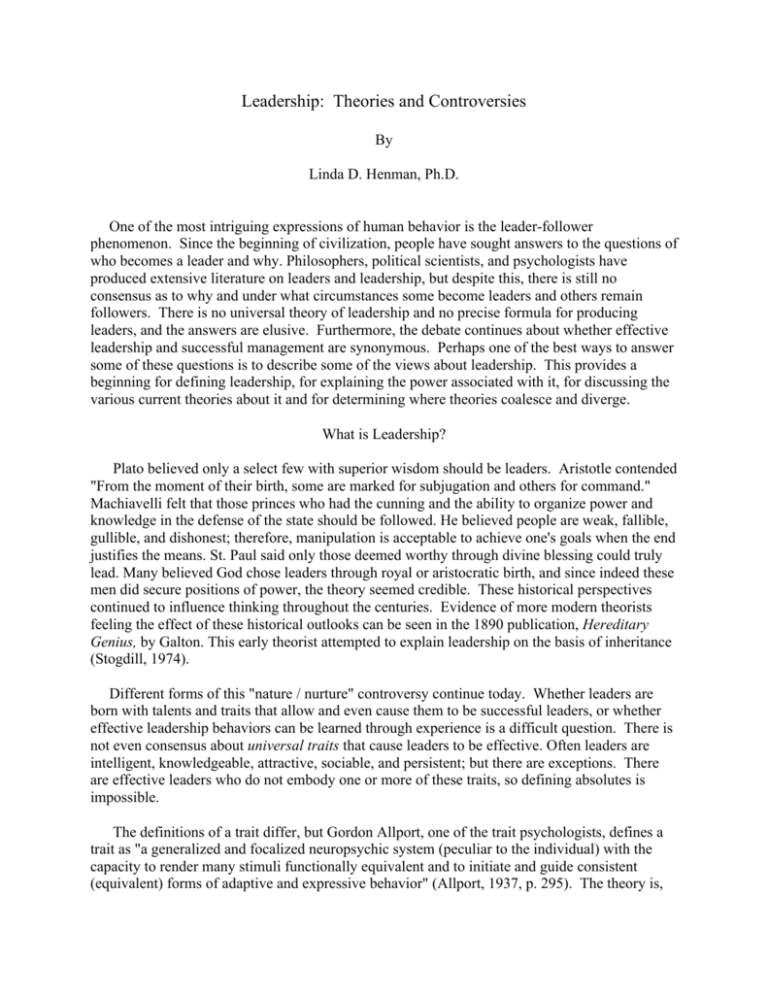
Leadership: Theories and Controversies By Linda D. Henman, Ph.D. One of the most intriguing expressions of human behavior is the leader-follower phenomenon. Since the beginning of civilization, people have sought answers to the questions of who becomes a leader and why. Philosophers, political scientists, and psychologists have produced extensive literature on leaders and leadership, but despite this, there is still no consensus as to why and under what circumstances some become leaders and others remain followers. There is no universal theory of leadership and no precise formula for producing leaders, and the answers are elusive. Furthermore, the debate continues about whether effective leadership and successful management are synonymous. Perhaps one of the best ways to answer some of these questions is to describe some of the views about leadership. This provides a beginning for defining leadership, for explaining the power associated with it, for discussing the various current theories about it and for determining where theories coalesce and diverge. What is Leadership? Plato believed only a select few with superior wisdom should be leaders. Aristotle contended "From the moment of their birth, some are marked for subjugation and others for command." Machiavelli felt that those princes who had the cunning and the ability to organize power and knowledge in the defense of the state should be followed. He believed people are weak, fallible, gullible, and dishonest; therefore, manipulation is acceptable to achieve one's goals when the end justifies the means. St. Paul said only those deemed worthy through divine blessing could truly lead. Many believed God chose leaders through royal or aristocratic birth, and since indeed these men did secure positions of power, the theory seemed credible. These historical perspectives continued to influence thinking throughout the centuries. Evidence of more modern theorists feeling the effect of these historical outlooks can be seen in the 1890 publication, Hereditary Genius, by Galton. This early theorist attempted to explain leadership on the basis of inheritance (Stogdill, 1974). Different forms of this "nature / nurture" controversy continue today. Whether leaders are born with talents and traits that allow and even cause them to be successful leaders, or whether effective leadership behaviors can be learned through experience is a difficult question. There is not even consensus about universal traits that cause leaders to be effective. Often leaders are intelligent, knowledgeable, attractive, sociable, and persistent; but there are exceptions. There are effective leaders who do not embody one or more of these traits, so defining absolutes is impossible. The definitions of a trait differ, but Gordon Allport, one of the trait psychologists, defines a trait as "a generalized and focalized neuropsychic system (peculiar to the individual) with the capacity to render many stimuli functionally equivalent and to initiate and guide consistent (equivalent) forms of adaptive and expressive behavior" (Allport, 1937, p. 295). The theory is, 2 then, that invisible traits exist in certain parts of the nervous system. Allport maintains that even though these specific traits are not viewable, their existence can be inferred from observing the consistencies in a person's behavior. In Allport's opinion, motives, passions preferences, and personal disposition all provide clues to the individual's personality. Other trait theorists view traits "as convenient constructs that are used to describe patterns of behaviors" (Ryckman, 1985, p. 194). There is clearly a division in the ranks of the trait theorists. Can factors of personality operate independently? Or are traits elements of a person that can be used to describe patterns of behavior? From 1920 to 1950 researchers, perhaps feeling the influence of the early trait theorists, tried to pinpoint factors that contribute to effective leadership. They reasoned that if leaders possess superior qualities that differentiate them from followers, discovering these qualities should be possible (Hodgetts, 1993, p. 278). In 1948 Ralph Stogdill published a review of one hundred twenty-four studies and surveys that had appeared in print between 1904 and 1947. Researchers in these studies identified characteristics such as initiative, social dominance, and persistence as general qualities of effectual leaders, but unfortunately, no common list of specific leadership traits surfaced. In fact, not only did Stogdill not discover a common list of leadership qualities, he also uncovered a number of inconsistent findings. From this search of the literature, Stogdill concluded, "A person does not become a leader by virtue of the possession of some combination of traits, but the pattern of personal characteristics of the leader must bear some relevant relationship to the characteristics, activities, and goals of the followers" (Stogdill, 1948). Stogdill's later work builds on his conclusions from the literature search, and he presents an interesting analysis of the trait theorists. He suggests that traits considered singly hold little diagnostic or predictive significance. In combination, however, they can generate personality dynamics, or patterns, rather than specific traits that are advantageous to the person in a leadership role (Stogdill, 1985). The distinction is, perhaps, theoretical hair splitting, but Stogdill criticizes that trait theories take an atomistic approach, viewing each personality variable as something that acts independently to determine leadership. According to Stodgill, Allport's approach is too narrow. In addition to the general observation that Allport's views are too restricted, a specific criticism of Allport's theory is that it is "restricted in the sense that it recognizes the influence of the environment in the development of personality but does not specify the ways in which the environment operates to affect functioning" (Ryckman, 1985, p. 218). "The situational approach, on the other hand, denied the influences of differences, attributing all variance between persons to fortuitous demands of the environment" (Stogdill, 1974, p. 82). While early trait theorists such as Allport gave little attention to determining what role the situation might play in leadership requirements, this controversy would receive more attention later as the situational theories of Fiedler and Hersey / Blanchard evolved (Fiedler, 1967 & Hersey / Blanchard, 1972). But a question does begin to surface. What role does chance or luck play in the rise of a leader? Would Hitler, for example, have been able to wreak such formidable havoc had he been at a different place or had lived in a different time? Henman Performance Group www.henmanperformancegroup.com 636.537.3774 3 In addition to no universal list of leadership traits existing, behaviors associated with great leadership are not consistent either. Based on his literature review, Stogdill identified six general factors he believes are associated with leaders: Capacity (intelligence, verbal fluency, judgment), achievement, responsibility, participation, status, and situation (Stogdill, 1948). But as Stogdill himself points out, there is not a universally accepted list of traits or behaviors. Theorists such as B.F. Skinner would argue that leadership is learned behavior influenced by genetics but not by the existence of spirits within the body (Skinner, 1974, p. 167). He contends that reinforcement of leadership behaviors and punishment or non-reinforcement of nonleadership behaviors determine who will become a leader. Although Skinner's approach to behaviorism generally is not popular among psychologists outside his sphere of influence, many behaviorists maintain that behaviors, such as leadership behaviors, can be explained and controlled purely by manipulation of the environment (Hall and Lindzey, 1957, p. 482). In Skinner's opinion it follows that if these leadership behaviors could be identified, they could be taught and learned. He directly challenges the notion that leaders are born, not made; however, another question is, can leadership be taught only to those who already possess the innate ability to lead? A trait theorists such as Allport might rebut this argument. Personality theories aside, some of the confusion and disagreement concerning this topic can be traced to a failure to distinguish between "the leader" and "leadership." As early as 1921 E.L. Munson defined leadership as "the ability to handle men so as to achieve the most with the least friction and cooperation." L.A. Allen's 1958 definition of a leader does not depart radically from this definition; rather Allen's perspective offers the idea that a leader is "one who guides and directs other people." If nothing else, "twentieth century social science research has established that leadership is a function of group process, rather than a series of traits residing in a particular individual. Clearly, there is no such thing as a "leader" apart from some particular group or organization. Leaders must have followers" (Cathcart & Samovar, 1984). According to the findings of Howard and Wilson (1982), there is also some evidence that leaders must have a desire to lead. In order to be effective, a person must want to lead. Even if an individual has the talent and training to lead but no motivation to work for a leadership position, success is unlikely. Sometimes a desire for popularity or a wish to avoid stress and responsibility cause an individual to seek non-leadership roles (Howard & Wilson, 1982, p. 34). Certainly there are those people who pass up promotions for various reasons. A motivational theorist such as Abraham Maslow (1968) would point out that such people are more motivated by needs that have nothing to do with the need for recognition, a need that is often satisfied by acquiring a leadership role. Satisfying needs is a motivator, according to Maslow, but what roles do the need to lead and the acceptance of leadership from another play? "Individuals form groups to satisfy needs that cannot otherwise be satisfied, and they accept direction for the same reason" (Cathcart & Samovar, 1984). A particular leader or shared leadership represents a means of fulfilling the group's needs better than could be done without direction. Leaders lead because groups demand direction and rely on leaders to satisfy needs; Henman Performance Group www.henmanperformancegroup.com 636.537.3774 4 and while not all groups have a leader, most groups have some form of leadership. In this frame of reference, describing the "universal" leader or the "ideal" leader is impossible. However describing leadership functions and roles and then discovering which members perform accordingly is possible. In this way, distinguishing between "leadership" as a group function, and "the leader," the person who is performing this function in a particular context, is possible. Functioning in a leadership role involves exerting influence and power. One person can play this role, or it can be shared among the group members. In most successful groups, there is one recognized leader, but the leadership responsibilities are shared among the members. The qualifying statement, "in most successful groups" introduces another question. Is the impact or effectiveness of the leader measured by the success of the followers? Certainly there are those who would immediately answer "yes!" Losing coaches get fired; CEO's of nonprofitable companies are terminated; and political candidates who make a poor showing at the polls are not elected. But in each of these cases does the failure of the group imply that leadership did not take place? Who would say that Robert E. Lee did not lead the Confederate forces? Are there those who would accuse Napoleon of not leading his men at Waterloo? Would anyone argue that Hitler did not come dangerously close to realizing his goal of creating a master race? In each of these examples, however, the followers failed. Lee, Napoleon, and Hitler were leaders of losing teams, but the history books still hail them as some of the most impressive leaders of all time. Has the criteria for measuring great leadership changed? Is leadership now defined solely by success? Perceptions and definitions do change with time, and perhaps there is a tendency today to measure success of the leader only by the accomplishments of the group. Another confusing question that has surfaced concerns differentiating between leadership and management. In recent years some attention has been given to the issue of whether leadership or management is needed in the organization. The obvious question, then, is what is the difference between the two? Definitions of the two differ depending on the author or the theorist, but some common criteria seem to exist for distinguishing between them. Abraham Zaleznik (1977) states that managers solve problems and continually coordinate and balance the people and the organization's assets. These managers need to possess persistence, tough-mindedness, intelligence, drive, analytical ability, tolerance, and good will (p. 68). Theodore Levitt (1976) does not differ greatly from Zaleznik. Levitt emphasizes that, management consists of the rational assessment of a situation and the systematic selection of goals and purposes (what is to be done?); the systematic development of strategies to achieve these goals; the marshaling of the required resources; the rational design, organization, direction, and control of the activities... (p. 73). Levitt stresses that rationality and control direct the energies of managers. Whether they are concentrating on goals, resources, organization structures or people, managers are problem solvers. Certainly neither Zalznik nor Levitt's definition of management is at cross purposes with the definition of leadership that most people have; however, it might be more limited. Often the Henman Performance Group www.henmanperformancegroup.com 636.537.3774 5 duties or responsibilities of managers are delineated. They are concrete, measurable, and observable. This makes defining what managers are and what they do somewhat easier than describing leaders or leadership. Frequently leaders perform all of the practical functions a manager would, but there seems to be a missing element. There is a mystique about leaders. The definitions of leadership involve abstract words such as visionary, charismatic, proactive, and purposeful. Since these terms are so nebulous, putting leadership in specific, observable terms is difficult; and a definition becomes elusive. There is often an emotional reaction to the word leader. It could be said that leaders inspire others to greater effort, and managers provide the necessary resources for that greater effort. Ideally, would the same person do both, allowing the inspiration and practical application to work in tandem? Could an effective leader lack practical managerial skills? Some would answer that all leaders are managers but not all managers are leaders. The lines between management and leadership are fuzzy because personal connotations overpower objective denotations. Although some real differences do exist in the perceptions of the two terms, for the purpose of this discussion, the two will be used interchangeably. This will allow a comparison and contrast of theories; some use the words "leadership theory" and others use the terms "managerial theory," but both address the power an individual has in an organization. Power in Groups One of the ways that leaders exert influence is through the use of power or control. The use of power affects goal accomplishment and interpersonal relationships because it governs behavior and regulates resources. The organizational members' perception of power is significant to this discussion because the members determine the variables that will influence their unique group. Power can be based on a variety of forces: legitimate power, coercive power, reward power, expert power, reference power, and informational power (Stogdill, 1985, p.293). Legitimate power is sometimes referred to as position power because it is the power the leader has based on an official role that he or she is performing. This type of leader is appointed, elected, designated, or emergent; but the members all recognize this person as the one who is officially in charge. Often, but not always, this type of leader has some of the other kinds of power that will augment the leadership role. One of these kinds of power may be coercive power, or the authority either to negate positive consequences or to deliver negative consequences. Coercive power usually does not work well since people seldom perform at optimum levels when they feel threatened. Skinner would advise against using punishment, stating that rewards for positive behavior and non-reinforcement of negative behavior are more effective. Other theorists disagree, and from a practical standpoint, there is evidence that people behave if they are afraid of consequences. Drivers do not speed because they fear tickets not because they have been rewarded for driving the speed limit. Dread of consequences frequently works, but there are other alternatives to punitive measures. Fear of punishment might stimulate followers to work hard to finish a project if they fear that their vacations will be canceled if they do not, but usually other kinds of pressure work better. Henman Performance Group www.henmanperformancegroup.com 636.537.3774 6 Using reward power, for instance, can have a more positive impact on performance. Frequently, tangible rewards such as monetary bonuses and vacation time are sources of power, but more often the rewards are intangible. Delivering goodwill, offering recognition, and giving compliments are all ways any member of an organization can exercise reward power. Using intangible reward power is one way individuals share the leadership role; failing to use it is one way to miss a valuable opportunity to build group cohesion. Expert power exists when group members consider a person to be qualified in a specific area. The nature of the expertise can be special knowledge, talent, or skill others recognize as superior. With regard to expert power, the interesting phenomenon is that being an expert is not enough; the others in the group must also recognize the person as an expert and treat him or her accordingly. Sometimes the nature of the power is not that the person is an authority in a certain field but that the individual possesses certain information. If a person has access to information or knowledge that other group members do not have, that person has some control over how and when to use the knowledge. Another type of power that can be linked to expert power is referent power. Commonly group members respect a person who is competent and trustworthy. This person can acquire referent power by being an expert in a given field, but sometimes this is not the case. At times an individual will acquire referent power by being likable, admirable, honorable, or charismatic. Since anyone can choose to be friendly or honorable, this type of power, like reward power, can be available in some for to all members. Power is not something that a person can demand; it must be given. Even a legitimate leader who has been assigned the role of leader may find exercising controlling prerogatives to be a challenge if followers resist. The way a person chooses to use power depends on the situation and the individual's style. Styles of Leadership Leadership style, more than leadership traits, determines leader effectiveness. Style is related to one's model of organizational behavior. The leader's style or manner of dealing with the organization's members and communicating with them contributes to or detracts from the group's overall functioning. Lippitt and White (1943) identified three general approaches to these interactions: authoritarian leadership style, democratic leadership style, and laissez-faire leadership style. Authoritarian, or autocratic, leadership relies on legitimate, coercive, and reward power to influence others. Sometimes these leaders are aggressive, parental, and dictatorial in their dealings with the group. However, while these approaches often work well in crisis situations, a constant use of this style can cause followers to be apathetic and unproductive when the leader's back is turned. In other words, when a leader constantly uses authoritarian leadership, the group members fail to develop a sense of ownership of their work. They will work if they are watched, but perhaps since they do not feel a part of the decision making process, they are not motivated Henman Performance Group www.henmanperformancegroup.com 636.537.3774 7 to do more than absolutely necessary. Also, they may become accustomed to the parental guidance of an autocratic leader and rely on it for motivation. Democratic leaders, on the other hand, share the decision making process. Members tend to be more satisfied and less frustrated when they play a part in the group's functioning. Sometimes the designated leader will still make the final decision after consulting the group members, but they feel more validated if their ideas are considered; and they are usually more motivated to implement the decision. Usually groups take longer than individuals to reach a decision, but often the morale payoff is worth the additional time. Lippitt and White found that "in general authoritarian groups were highest in quantity, while the democratic groups were highest in quality of product and in morale" (Stogdill, 1974, p. 205). Laissez-faire leaders exert little or no influence on the group. In essence, these groups are a collection of equals. Depending on the definition of leader, some would argue that these groups do not have leaders. As mentioned earlier, perhaps laissez-faire leadership would better be defined as a function of group process rather than as an activity one person performs. Since no one dominates the group, the members rely on each other for direction. This can work if the individuals are capable and driven; however, it can fail if the group is unmotivated or immature in the task. Lewin, Lippitt, and White hailed democratic leadership as the best of the three styles, but no one style is indicated all of the time. Democratic leadership works well when nonstressful, moderate conditions prevail, but autocratic leadership is more suitable during a crisis or high stress situation. Even the laissez-faire style can work well if the group is self-directed and motivated. The situational theorists would tackle the question of appropriate leadership style twenty years after the initial studies by Lewin, Lippitt, and White. Leadership Theories Not only is there no agreement about a theory of leadership, there are those who question the very notion of leadership. They believe the present emphasis on individualism and freedom of choice is at odds with the traditional reliance on strong, effective leaders. Some people would purposefully avoid leadership because they believe it requires the manipulation of other persons and limits people's freedom of choice. These individuals tend to associate leadership with elitism and the kind of power-seeking which sometimes leads to corruption of goals and unnecessary conflict. Some would go so far as to say that modern education and mass communication make leaders unnecessary. As yet, however, there has been no indication that leaders are no longer necessary, and apparently there are no successful groups without leadership. Even when some members of a group consciously avoid leader roles, others arise to fill the void. The question, then, is not whether there should or should not be leaders, but what constitutes the most effective and desirable leadership for a given organization. Henman Performance Group www.henmanperformancegroup.com 636.537.3774 8 In 1960 Douglas McGregor offered a theory that encompasses style, behavior, situation and adaptation to the situation. He contends that assumptions about the nature of the organization's personnel will determine the style the manager will use in leading and that most management actions flow directly from whatever theory of human behavior the manager holds. McGregor calls these assumptions Theory X and Theory Y. Theory X managers assume people are basically lazy and by their very nature dislike work. Since people have little ambition and tend to shun responsibility, they avoid work when possible. Managers must, therefore, use coercion and threats of punishment to attain organizational objectives. These autocratic managers feel such stringent control is in the organization's best interest (McGregor, 1960, p.33). Theory Y managers, on the other hand, believe the expenditure of physical and mental effort in work is as natural to people as resting or playing. People are not inherently shiftless; experience has taught them to be lazy. It follows, then, that external control and threats of punishment are not the only ways or the best ways of motivating people to work toward organizational objectives. Rather, if people are committed to goals, they will exercise selfdirection and self-control to attain them. Y leaders are participative leaders who invite decision sharing. They do so because they recognize that imagination, ingenuity, and creativity are widely distributed throughout the organization. Given proper conditions, employees not only will accept responsibility, they will also seek it (McGregor, 1960, p. 47). McGregor's argument is that leaders have been following an outdated set of assumptions because they have embraced Theory X. McGregor contends that most people are closer to the Theory Y set of assumptions and that management needs to change its attitudes about people. Is the Theory Y manager always superior to the Theory X manager? Modern thinking might suggest that it is; however, Theory Y is not without its critics. Some would argue that only under certain conditions will the interactive and consultative characteristics of this democratic style work. Sometimes, these faultfinders would argue, circumstances and particular people demand a more authoritative approach. McGregor's approach to leadership helped to forge the way for further development of the situational theories. These later theorists would attempt to bring into focus the problem of how to attain productivity without underrating workers. The situational theories or contingency theories began in the 1960's. The basis of these theories is that individuals' characteristics make them suitable leaders only in certain situations. Since each situation requires a leader to vary behavior to fit the prevailing circumstances, groups do well to match the leader to the present state of affairs. In other words, there is no right or wrong way to lead all of the time. Matching leaders and groups who meet each other's needs and skills is advised. The situational theorists address the need to consider both the task and social-emotional needs of the group. In l967 Fred Fiedler proposed his contingency theory to determine when a task- Henman Performance Group www.henmanperformancegroup.com 636.537.3774 9 oriented approach would be more effective and when a relationship-oriented style would be more productive. He concluded that task-oriented leaders are effective when conditions are either "very favorable for the leader or which are very unfavorable for the leader" (Fiedler, 1967, p.13). When conditions are favorable, member relations are strong; there is a positive relationship between the group and the leader; and the task is clear and structured. The group members are ready and willing to work, and their energies can be focused on the goal. Task-oriented leaders are effective because they support job performance. As odd as it may seem, the same type of task-oriented leader is called for if the situation is bad. When conditions are unfavorable, when there are poor relations within the organization, or when the task is ambiguous or undesirable, the group will need to stay goal oriented in order to achieve any success; so the task-oriented leader is once again indicated. For example, in unfavorable circumstances or in stressful situations, a leader's structure and control can remove undesirable ambiguity and the anxiety that goes with it. According to Fiedler (1967), "the relationship-oriented style is more effective in situations which are intermediate in favorableness" (p.13). Favorableness of the situation occurs when moderate, non-crisis conditions prevail or when the situation enables the leader to exert influence. When an intermediate situation is present, the leader can help to build confidence and cohesion by focusing on the personal needs of the individuals. Democratic leadership tends to trigger group involvement, and that, in turn, tends to engender individual satisfaction. Whether the situation is favorable or unfavorable, Fiedler's model suggests that "group performance can...be improved either by modifying the leader's style or by modifying the group-task situation" (p. 151). For some, Fiedler's theory seems too narrow. These critics find this theory to be a simplistic recipe for success. Furthermore, the theory fails to address a number of questions. For instance, are there situations when neither an employee-oriented or structured leader is indicated? Substitutes for leadership, such as empowered work teams and quality circles, might be indicated. Fiedler's defense might be that within these smaller structures the situation determines the kind of task-oriented or relationship-oriented leader that would be most effective. Another situational theory that deals with task behaviors and relationship behaviors is the Hersey / Blanchard Theory. This theory was introduced about ten years after Fiedler's theory, and while similar in its focus on task and relationship, it differs in significant areas. First, Paul Hersey and Kenneth Blanchard assume that leaders are more flexible than Fiedler does. They maintain the leader should change behavior as the followers' maturity increases. This is the first of the situational theories to address the element of follower maturity. Maturity is defined as "the capacity to set high but attainable goals (achievement-motivation), willingness and ability to take responsibility, and education and / or experience of an individual or a group" (Hersey, Blanchard, 1976). Hersey and Blanchard point out that variables of maturity should be considered only in relation to a specific task. That is, followers are not mature or immature in any total or chronological sense; rather, they have varying degrees of maturity depending on knowledge of or experience with a specific goal. The effective leader must determine the group's maturity before Henman Performance Group www.henmanperformancegroup.com 636.537.3774 10 assessing the amount of guidance needed. This theory is based on determining the optimum amount of direction and socio-emotional support a leader must provide, given the specific situation and the level of maturity of the follower or group. These theorists dispelled the notion that task and relationship are either / or styles of leadership. Instead, these styles can be viewed as existing on a continuum, moving from very authoritarian leadership at one end to very democratic leadership behavior at the other. A new, immature group needs direction and goal oriented behavior that Hersey and Blanchard call telling. The task-oriented leader engages in one-way communication by explaining what followers are to do, when, where, and how they are to do it. The followers are usually eager to accept guidance when they feel uncertain about the task or the ability of the group to perform. During this initial stage, when followers are immature in the task, the leader is advised to exhibit high task and low relationship behavior. This is the most autocratic of the four styles Hersey and Blanchard describe. As the group matures, it is ready to build relationship behavior, and the leader's selling ideas is appropriate. At this selling stage, the leader's task related behaviors remain somewhat high but begin to decrease as the relationship behaviors increase. The followers are now ready for more involvement in reaching the objective. Two-way communication and socio-emotional support exists in this stage because leaders are trying to persuade the group to "buy" what they are selling. As the experience level, motivation, and willingness to take responsibility increase, the leader's involvement should further decrease. During the next stage, participating is indicated. The encouragement of the group's participating involves high relationship and low task behavior on the part of the leader. Since the followers have the ability and experience to perform the task, the group can now share in decision making through two-way communication. The leader is needed as a facilitator rather than as a director. The leader's eventual delegating of responsibility is the next step in the process. As the group shows its readiness to be more autonomous, the leader should allow shared leadership and responsibility. Now the group is ready for low relationship and low task behavior. Followers are willing and able to take responsibility for decisions and actions. The leader is needed very little and should allow the group to function on its own. One of the current most popular explanations of leadership behavior is the Blake / Mouton Managerial Grid. Once again, this approach describes the relationship between the leader's concern for task and concern for people, but this theory differs in its perspective. Robert Blake and Jane Mouton offer a model that is more concrete in depicting variations which can take place in a leader's behavior. They discuss these variations by fist identifying what they term the "organization universals": purpose, people, power (hierarchy), and organization culture (Blake and Mouton, 1985, p. 9). The reduced these organization universals to two leadership concerns: a concern for production and a concern for people. The leader's concern for goal achievement and people's feelings are each assigned a one to nine numerical equivalent, with one showing very little concern and nine showing high concern. Henman Performance Group www.henmanperformancegroup.com 636.537.3774 11 Charting these numbers on a horizontal axis measures a leader's concern for production, and comparing it to a vertical axis hat measures the leader's concern for people gives a clearer picture of the balance that exists between the two behaviors. These theorists maintain that several conditions will determine the dominant managerial assumptions for a given person under a particular set of circumstances. First, the organization itself plays a role in the leader's behavior. Repeatedly, culture, norms, or rules dictate behaviors a leader would not ordinarily adopt. Usually, however, leaders' values, personal history, and chance predispose them to use one approach one another. For example, a 9-1 manager, or production pusher, might have concluded that task, above all else, should be the manager's primary concern. The 1-9 manager, or country club manager, on the other hand, has somehow reached the conclusion that concentrating on people and their needs is critical. Beliefs about appropriate leaders behavior and personal experiences frequently determine managerial style (Blake and Mouton, 1985, p. 14). a leader who adopts a 9-9 style will, according to Blake and Mouton, be the most successful because of the high concern for both task and people. Each theory differs slightly, indicating that there is no one best, all-purpose style of leadership. The successful leader is the one who can adapt to the unique demands of an everchanging organization. An effective leader needs to diagnose the needs and wants of followers and then react accordingly, remembering all the while that the group is becoming more experienced and less dependent on direction. Recognizing the power that the leader has and the power that the group members share helps leaders and followers more effectively share the leadership functions and contribute to overall productivity. Conclusion Defining and explaining leadership, its theories and controversies is a monumental task. So much must be considerate. Psychology, history, sociology, religion, and business are just a few of the areas that should be considered when approaching this topic; and yet it is still overwhelming. The search for answers continues, and the questions continue to change too. However, describing the controversies and theories in a given area creates a basis for examination and discovery. Plato, Aristotle, Machiavelli, and St. Paul might not agree with current theories, but they would probably be faced with the need to reexamine some of their thinking. REFERENCE LIST Allen, L.A. (1958). Management & organizations New York: McGraw-Hill. Allport, G.W. (1937). Personality: a psychological interpretation. New York: Holt. Blake, R.R. & Mouton, J. S. (1985). The managerial grid III: The key to leadership excellence. Houston: Gulf Publishing. Cathcart, R.S. & Samovar, L.A. (1984). Small group communication: a reader. , Madison, WI: Wm. C. Brown Publishing. Fiedler, F.E. (1967). A theory of leadership effectiveness. New York: McGraw-Hill. Henman Performance Group www.henmanperformancegroup.com 636.537.3774 12 Hall, C.S. & Lindzey, G.(1957). Theories of personality. New York: John Wiley & Sons Inc. Hersey, P. & Blanchard, K. (1972). Situational leadership, Center for leadership studies, [Brochure]. Howard, A. & Wilson, J. (Summer, 1982). Leadership in a declining work ethic. California management review. 33-46. Hodgetts, R. (1992). Modern human relations at work, Fort Worth: Dryden Press. Levitt, T. (Summer, 1976). The management and the post industrial society. The public interest. Lewin, K. Lippitt, R. & White, R.K. (1939). Patterns of aggressive behavior in experimentally created "social climates," Journal of Social Psychology, 10, 271-299. Maslow, A.H. (1968). Toward a psychology of being. New York: D. Van Nostrand Co. McGregor, D. (1960). The human side of enterprise. New York: McGraw-Hill. Munson, E. L. (1921). The management of men. New York: Holt. Ryckman, R. (1985). Theories of personality. Monterey, CA: Brooks / Cole Publishing Co. Skinner, B. F. (1974). About behaviorism, New York: Knopf. Stogdill, R. (1948). Personal factors associated with leadership: A survey of the literature. Journal of Psychology, 25, 35-71. Stogdill, R. (1974). Handbook of leadership. New York: The Free Press. Zalznik, A. (May-June, 1977) Managers & leaders: Are they different? Harvard business review. Henman Performance Group www.henmanperformancegroup.com 636.537.3774
